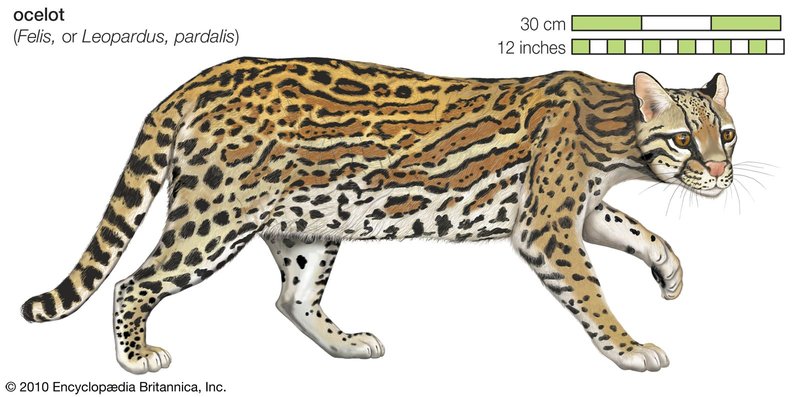
Imagine a family tree — not of humans, but of cats. The ocelot is like a branch on that tree, but it’s connected to a long line of ancestors that have shaped who they are today. Their journey is marked by changes in their habitats, behaviors, and even their genetics. As we explore the evolutionary history of the ocelot, we’ll see how they evolved from their distant relatives and adapted to become the agile hunters they are now.
The Ancestral Lineage of the Ocelot
The story of the ocelot begins long before they roamed the Earth. The ocelot belongs to the Felidae family, which includes all cats, from the tiny domestic house cat to the majestic lion. This family shares common ancestors that date back about 10–15 million years. During this time, cats started to diversify into various species.
Most scientists believe that the lineage leading to the ocelot separated from other wild cats around 2 million years ago. This is when ocelots began to develop their unique traits. They evolved alongside the changing environments of the Americas, learning to adapt to a variety of habitats, from dense rainforests to arid grasslands.
Imagine being an ancient feline, wandering through lush forests. You’d need to be quick and stealthy to catch your prey, and over time, those who could do this best would thrive. This evolutionary pressure led to the development of the ocelot’s strong limbs and sharp claws, perfect for climbing trees and navigating through thick underbrush.
The Ocelot’s Unique Adaptations
Ocelots are known for their striking fur patterns, and these patterns are more than just beautiful. They serve an important purpose in survival. The rosettes and spots help the ocelot blend into the dappled light of the forest, acting like nature’s camouflage. This adaptation is crucial for stalking prey, like rabbits and birds.
Their keen sense of hearing and acute eyesight, particularly in low light, are also critical adaptations. Ocelots are primarily nocturnal, meaning they’re most active at night. This behavior helps them avoid larger predators and increases their chances of catching dinner. Imagine wandering through the dark, relying on your senses to guide you; that’s life as an ocelot!
Besides their physical traits, ocelots have also developed a complex social behavior. While some cats prefer solitude, ocelots are a bit more social. They often communicate with each other through vocalizations and scent marking, allowing them to establish territories without direct confrontation.
The Impact of Climate Change on Ocelots
Climate change has had a profound effect on wildlife all over the world, including ocelots. Over the past century, habitat loss due to deforestation and urbanization has become a pressing issue for these cats. With their habitats shrinking, ocelots face new challenges.
As jungles and forests are cleared, ocelots must adapt to fragmented landscapes. They might find themselves forced to travel longer distances to find food or mates. This change can lead to increased competition for resources and even inbreeding in isolated populations.
You might wonder how they cope with these changes. Some ocelots have learned to thrive in areas closer to human settlements, showing their impressive adaptability. However, this isn’t always a solution, as human interactions can lead to conflicts, often resulting in tragic outcomes for these beautiful animals.
Conservation Efforts and Their Importance
Given the challenges ocelots face, conservation efforts play a vital role in their survival. Many organizations are working tirelessly to protect ocelot habitats and reduce conflicts with humans. This includes creating wildlife corridors that allow ocelots to safely move between fragmented areas.
In addition to habitat conservation, education is key. By raising awareness about the importance of ocelots in the ecosystem and how to live harmoniously alongside them, humans can help ensure a brighter future for these magnificent creatures.
You might be wondering what you can do to help. Simple actions, like supporting wildlife conservation organizations or spreading the word about the ocelot’s plight, can make a difference. Every bit helps!
The Future of the Ocelot
The future of the ocelot hangs in the balance, shaped by both their remarkable evolutionary history and the challenges they face today. It’s a hopeful narrative, as ocelots are resilient creatures that have adapted through time. However, their survival will depend on our efforts to protect their environments and bring awareness to their needs.
As we continue to understand their history and unique adaptations, we also recognize the responsibility we have to ensure they thrive for generations to come. Whether it’s through preservation efforts or simply learning more about these incredible cats, every step matters.
The evolutionary history of the ocelot is a reminder of nature’s resilience. It teaches us that, even in the face of change, creatures can adapt and evolve. When we look at an ocelot, we’re not just seeing a beautiful animal; we’re witnessing a story that spans millions of years. So next time you see one, remember it carries the legacy of its ancestors and the hope for a continued future in the wild.
